Evaluating Talent Management Strategies at Boots UK: HR Role
VerifiedAdded on 2023/06/18
|22
|4530
|57
Report
AI Summary
This report evaluates the role of Human Resource managers in addressing organizational challenges related to attracting fresh talent, using Boots UK as a case study. It explores the purpose of talent management, the impact of HR strategies, and the challenges faced in managing talent. The research employs a deductive approach and qualitative methods, utilizing both primary (questionnaires) and secondary data sources. The findings highlight the importance of effective HR strategies in boosting performance, improving accountability, and retaining talented employees. Challenges such as encouraging passion, offering competitive salaries, and creating engaging work are also discussed. The report concludes by emphasizing the need for HR departments to proactively address these challenges to improve productivity and achieve organizational goals. Desklib provides access to similar solved assignments and study resources for students.
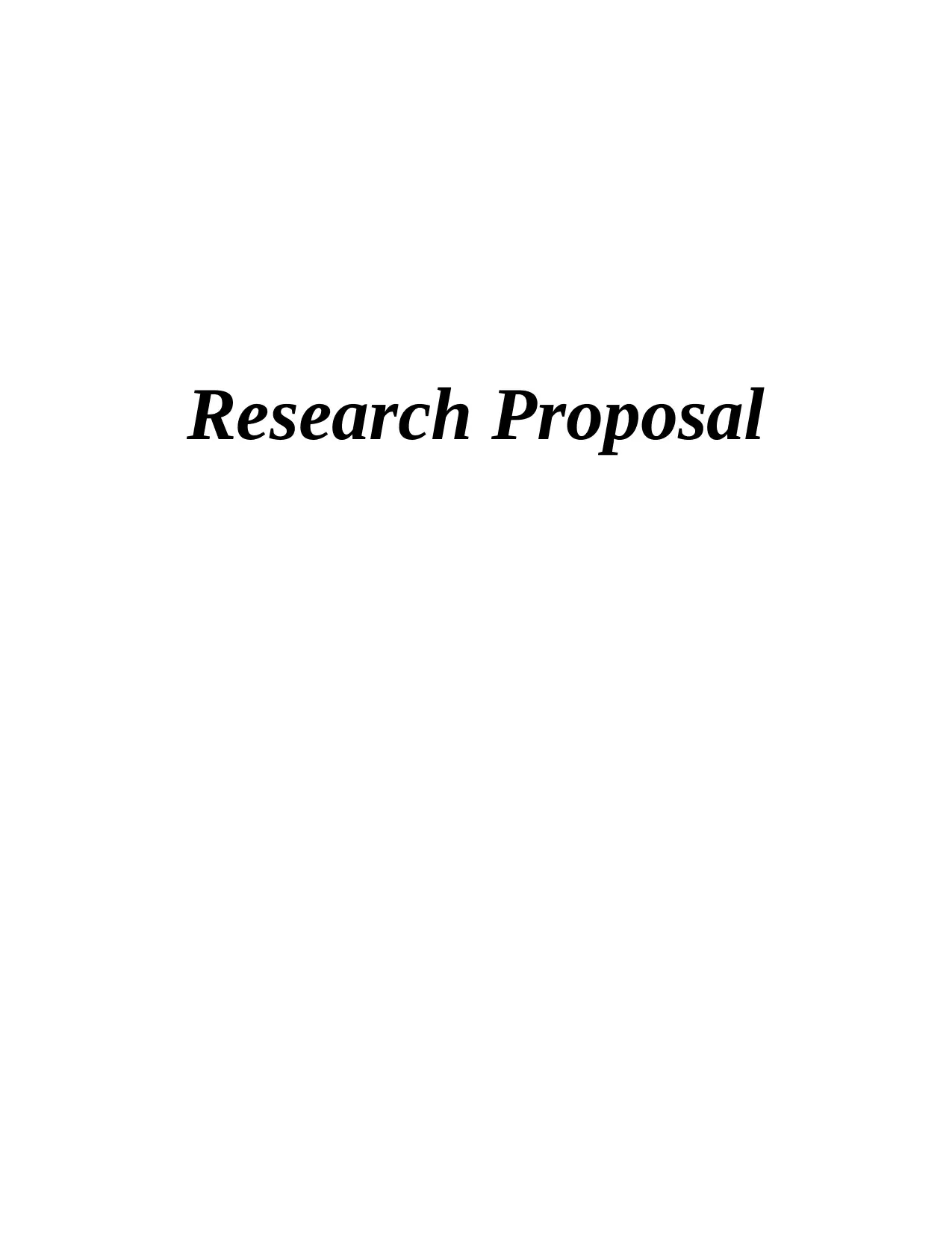
Research Proposal
Paraphrase This Document
Need a fresh take? Get an instant paraphrase of this document with our AI Paraphraser
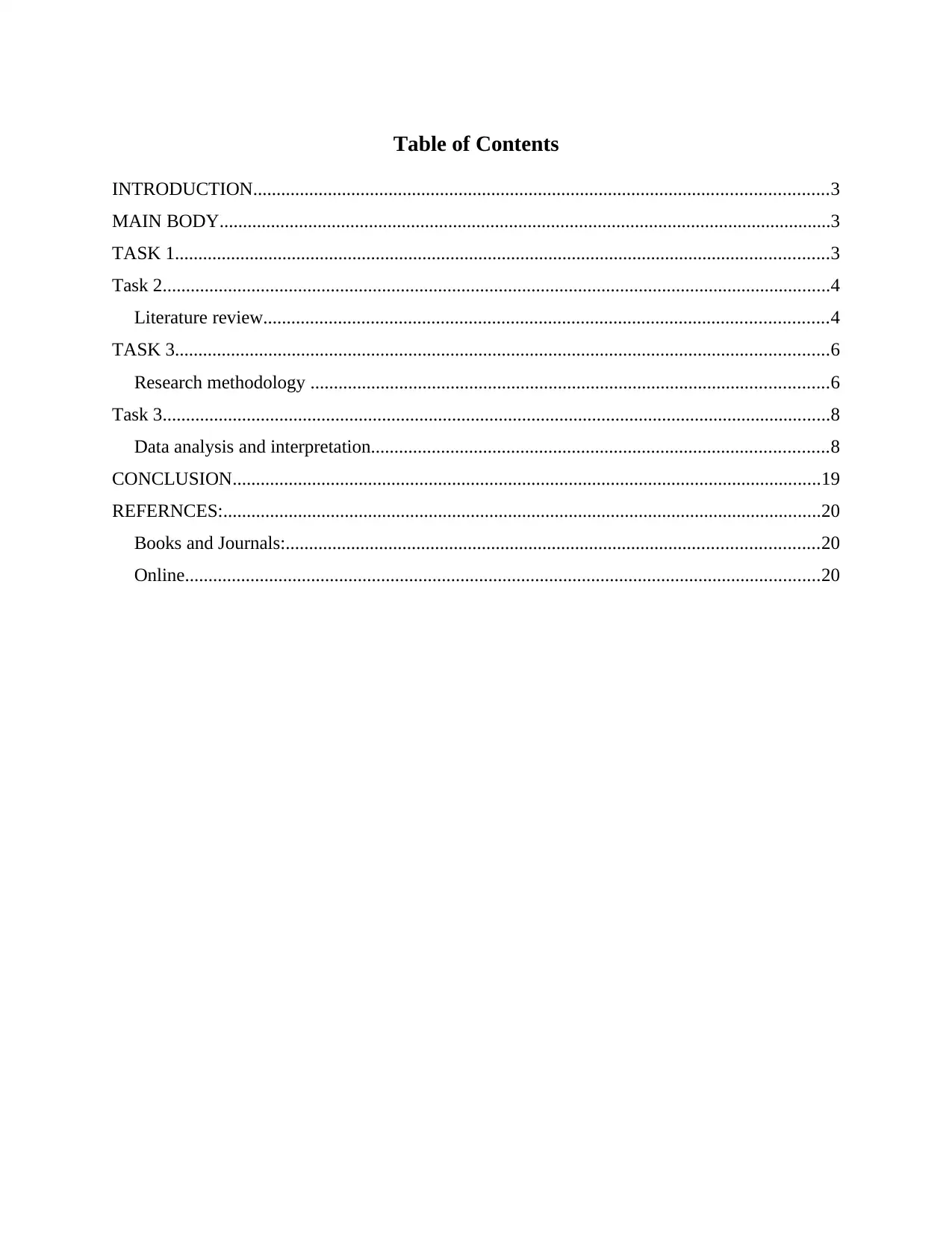
Table of Contents
INTRODUCTION...........................................................................................................................3
MAIN BODY...................................................................................................................................3
TASK 1............................................................................................................................................3
Task 2...............................................................................................................................................4
Literature review.........................................................................................................................4
TASK 3............................................................................................................................................6
Research methodology ...............................................................................................................6
Task 3...............................................................................................................................................8
Data analysis and interpretation..................................................................................................8
CONCLUSION..............................................................................................................................19
REFERNCES:................................................................................................................................20
Books and Journals:..................................................................................................................20
Online........................................................................................................................................20
INTRODUCTION...........................................................................................................................3
MAIN BODY...................................................................................................................................3
TASK 1............................................................................................................................................3
Task 2...............................................................................................................................................4
Literature review.........................................................................................................................4
TASK 3............................................................................................................................................6
Research methodology ...............................................................................................................6
Task 3...............................................................................................................................................8
Data analysis and interpretation..................................................................................................8
CONCLUSION..............................................................................................................................19
REFERNCES:................................................................................................................................20
Books and Journals:..................................................................................................................20
Online........................................................................................................................................20
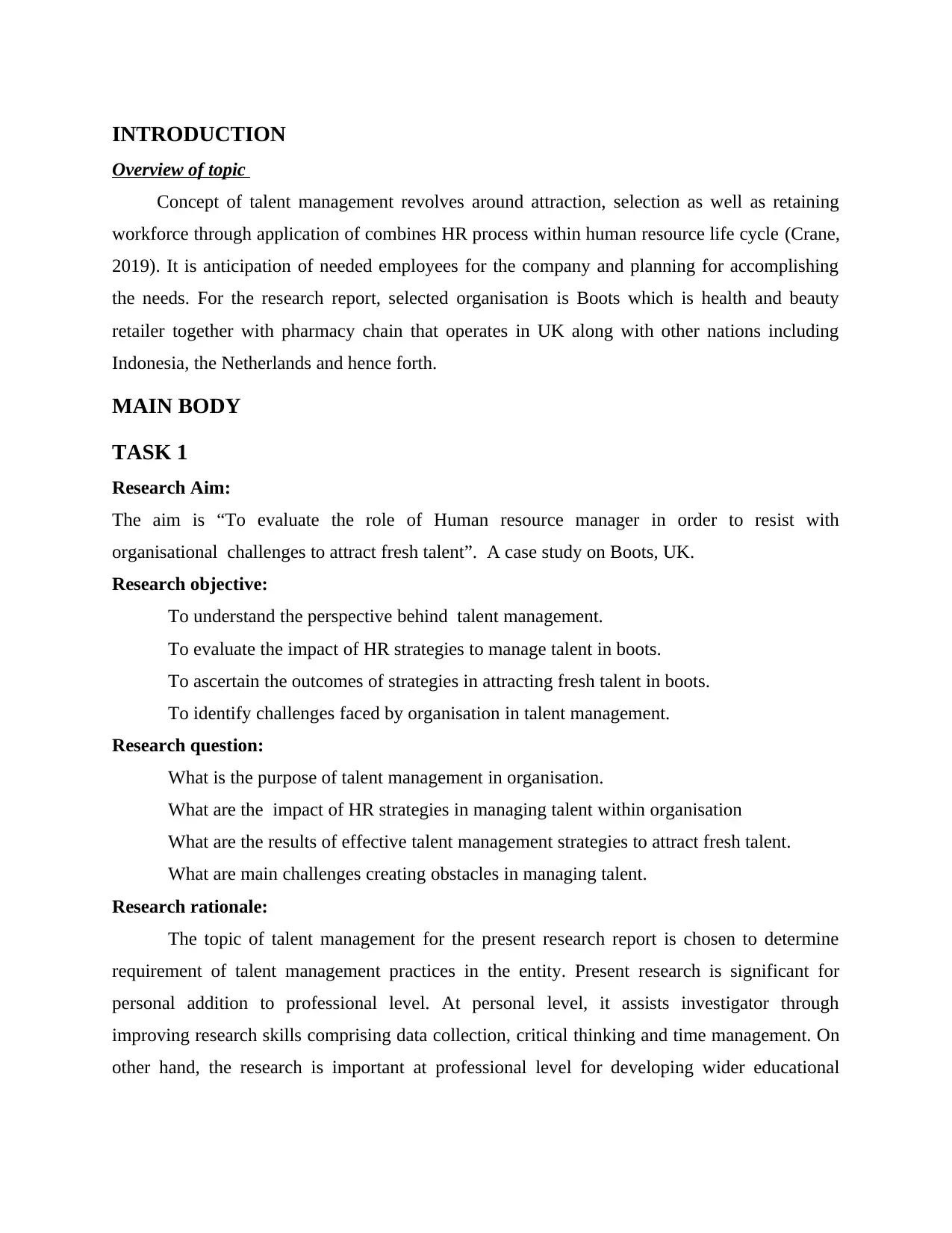
INTRODUCTION
Overview of topic
Concept of talent management revolves around attraction, selection as well as retaining
workforce through application of combines HR process within human resource life cycle (Crane,
2019). It is anticipation of needed employees for the company and planning for accomplishing
the needs. For the research report, selected organisation is Boots which is health and beauty
retailer together with pharmacy chain that operates in UK along with other nations including
Indonesia, the Netherlands and hence forth.
MAIN BODY
TASK 1
Research Aim:
The aim is “To evaluate the role of Human resource manager in order to resist with
organisational challenges to attract fresh talent”. A case study on Boots, UK.
Research objective:
To understand the perspective behind talent management.
To evaluate the impact of HR strategies to manage talent in boots.
To ascertain the outcomes of strategies in attracting fresh talent in boots.
To identify challenges faced by organisation in talent management.
Research question:
What is the purpose of talent management in organisation.
What are the impact of HR strategies in managing talent within organisation
What are the results of effective talent management strategies to attract fresh talent.
What are main challenges creating obstacles in managing talent.
Research rationale:
The topic of talent management for the present research report is chosen to determine
requirement of talent management practices in the entity. Present research is significant for
personal addition to professional level. At personal level, it assists investigator through
improving research skills comprising data collection, critical thinking and time management. On
other hand, the research is important at professional level for developing wider educational
Overview of topic
Concept of talent management revolves around attraction, selection as well as retaining
workforce through application of combines HR process within human resource life cycle (Crane,
2019). It is anticipation of needed employees for the company and planning for accomplishing
the needs. For the research report, selected organisation is Boots which is health and beauty
retailer together with pharmacy chain that operates in UK along with other nations including
Indonesia, the Netherlands and hence forth.
MAIN BODY
TASK 1
Research Aim:
The aim is “To evaluate the role of Human resource manager in order to resist with
organisational challenges to attract fresh talent”. A case study on Boots, UK.
Research objective:
To understand the perspective behind talent management.
To evaluate the impact of HR strategies to manage talent in boots.
To ascertain the outcomes of strategies in attracting fresh talent in boots.
To identify challenges faced by organisation in talent management.
Research question:
What is the purpose of talent management in organisation.
What are the impact of HR strategies in managing talent within organisation
What are the results of effective talent management strategies to attract fresh talent.
What are main challenges creating obstacles in managing talent.
Research rationale:
The topic of talent management for the present research report is chosen to determine
requirement of talent management practices in the entity. Present research is significant for
personal addition to professional level. At personal level, it assists investigator through
improving research skills comprising data collection, critical thinking and time management. On
other hand, the research is important at professional level for developing wider educational
⊘ This is a preview!⊘
Do you want full access?
Subscribe today to unlock all pages.

Trusted by 1+ million students worldwide
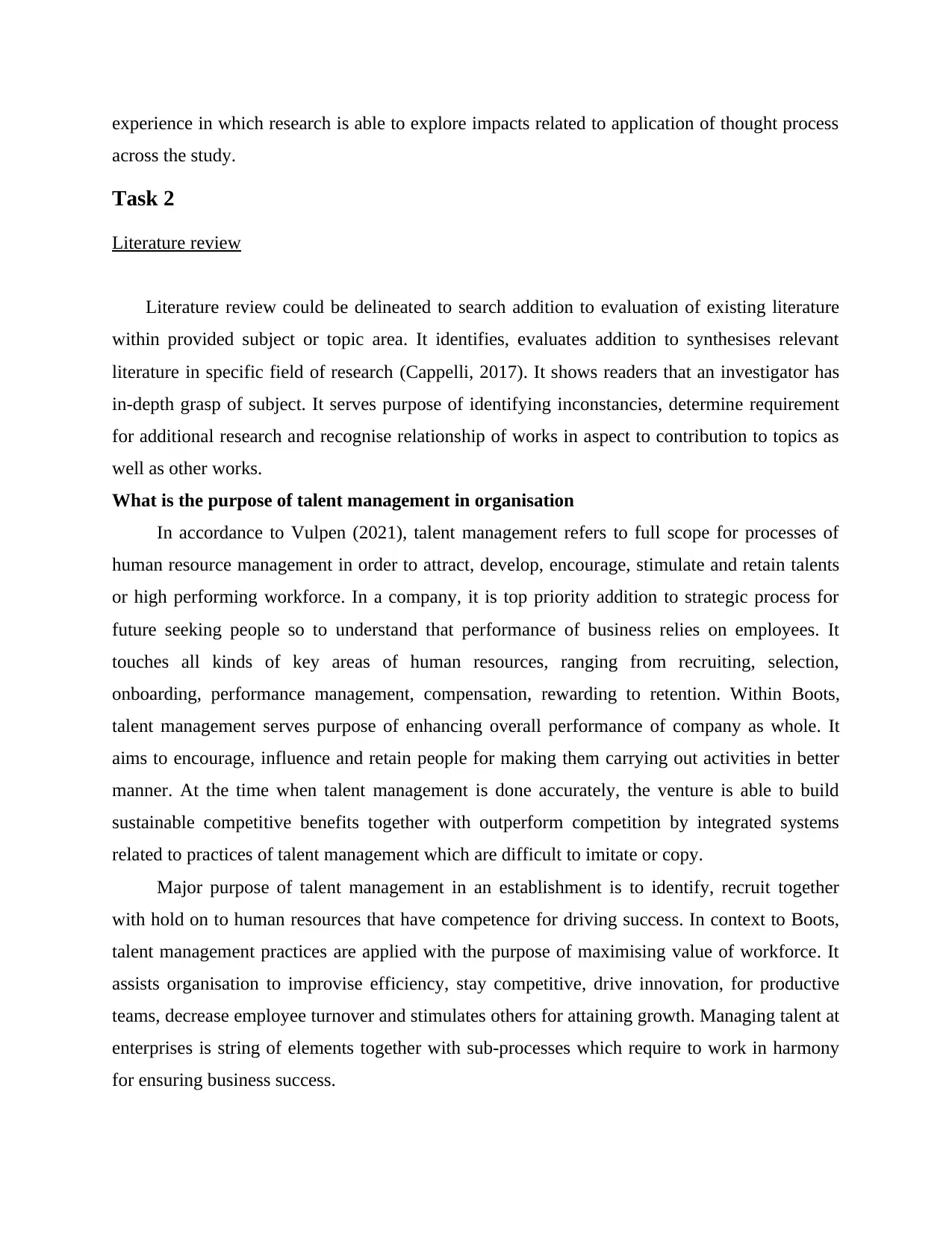
experience in which research is able to explore impacts related to application of thought process
across the study.
Task 2
Literature review
Literature review could be delineated to search addition to evaluation of existing literature
within provided subject or topic area. It identifies, evaluates addition to synthesises relevant
literature in specific field of research (Cappelli, 2017). It shows readers that an investigator has
in-depth grasp of subject. It serves purpose of identifying inconstancies, determine requirement
for additional research and recognise relationship of works in aspect to contribution to topics as
well as other works.
What is the purpose of talent management in organisation
In accordance to Vulpen (2021), talent management refers to full scope for processes of
human resource management in order to attract, develop, encourage, stimulate and retain talents
or high performing workforce. In a company, it is top priority addition to strategic process for
future seeking people so to understand that performance of business relies on employees. It
touches all kinds of key areas of human resources, ranging from recruiting, selection,
onboarding, performance management, compensation, rewarding to retention. Within Boots,
talent management serves purpose of enhancing overall performance of company as whole. It
aims to encourage, influence and retain people for making them carrying out activities in better
manner. At the time when talent management is done accurately, the venture is able to build
sustainable competitive benefits together with outperform competition by integrated systems
related to practices of talent management which are difficult to imitate or copy.
Major purpose of talent management in an establishment is to identify, recruit together
with hold on to human resources that have competence for driving success. In context to Boots,
talent management practices are applied with the purpose of maximising value of workforce. It
assists organisation to improvise efficiency, stay competitive, drive innovation, for productive
teams, decrease employee turnover and stimulates others for attaining growth. Managing talent at
enterprises is string of elements together with sub-processes which require to work in harmony
for ensuring business success.
across the study.
Task 2
Literature review
Literature review could be delineated to search addition to evaluation of existing literature
within provided subject or topic area. It identifies, evaluates addition to synthesises relevant
literature in specific field of research (Cappelli, 2017). It shows readers that an investigator has
in-depth grasp of subject. It serves purpose of identifying inconstancies, determine requirement
for additional research and recognise relationship of works in aspect to contribution to topics as
well as other works.
What is the purpose of talent management in organisation
In accordance to Vulpen (2021), talent management refers to full scope for processes of
human resource management in order to attract, develop, encourage, stimulate and retain talents
or high performing workforce. In a company, it is top priority addition to strategic process for
future seeking people so to understand that performance of business relies on employees. It
touches all kinds of key areas of human resources, ranging from recruiting, selection,
onboarding, performance management, compensation, rewarding to retention. Within Boots,
talent management serves purpose of enhancing overall performance of company as whole. It
aims to encourage, influence and retain people for making them carrying out activities in better
manner. At the time when talent management is done accurately, the venture is able to build
sustainable competitive benefits together with outperform competition by integrated systems
related to practices of talent management which are difficult to imitate or copy.
Major purpose of talent management in an establishment is to identify, recruit together
with hold on to human resources that have competence for driving success. In context to Boots,
talent management practices are applied with the purpose of maximising value of workforce. It
assists organisation to improvise efficiency, stay competitive, drive innovation, for productive
teams, decrease employee turnover and stimulates others for attaining growth. Managing talent at
enterprises is string of elements together with sub-processes which require to work in harmony
for ensuring business success.
Paraphrase This Document
Need a fresh take? Get an instant paraphrase of this document with our AI Paraphraser
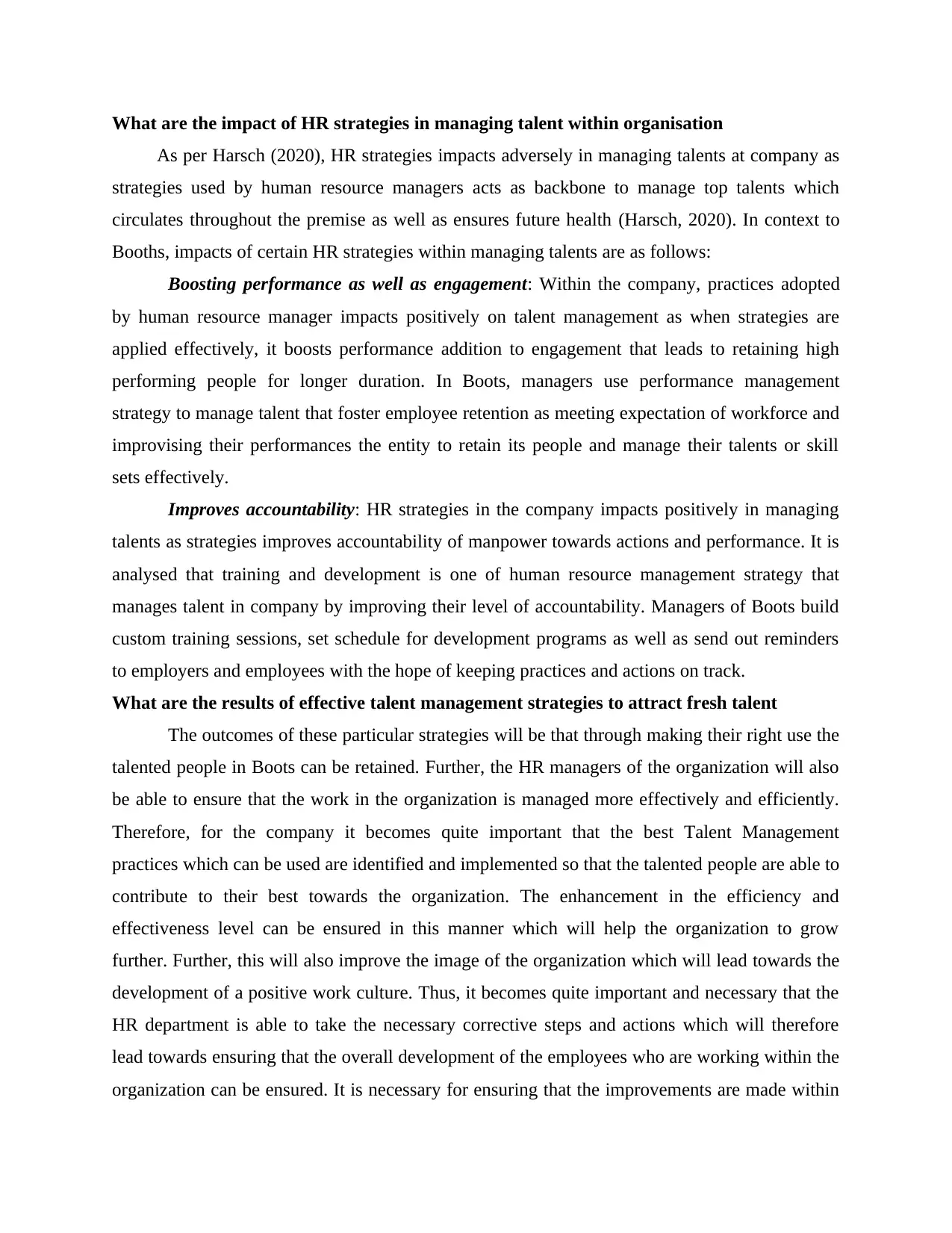
What are the impact of HR strategies in managing talent within organisation
As per Harsch (2020), HR strategies impacts adversely in managing talents at company as
strategies used by human resource managers acts as backbone to manage top talents which
circulates throughout the premise as well as ensures future health (Harsch, 2020). In context to
Booths, impacts of certain HR strategies within managing talents are as follows:
Boosting performance as well as engagement: Within the company, practices adopted
by human resource manager impacts positively on talent management as when strategies are
applied effectively, it boosts performance addition to engagement that leads to retaining high
performing people for longer duration. In Boots, managers use performance management
strategy to manage talent that foster employee retention as meeting expectation of workforce and
improvising their performances the entity to retain its people and manage their talents or skill
sets effectively.
Improves accountability: HR strategies in the company impacts positively in managing
talents as strategies improves accountability of manpower towards actions and performance. It is
analysed that training and development is one of human resource management strategy that
manages talent in company by improving their level of accountability. Managers of Boots build
custom training sessions, set schedule for development programs as well as send out reminders
to employers and employees with the hope of keeping practices and actions on track.
What are the results of effective talent management strategies to attract fresh talent
The outcomes of these particular strategies will be that through making their right use the
talented people in Boots can be retained. Further, the HR managers of the organization will also
be able to ensure that the work in the organization is managed more effectively and efficiently.
Therefore, for the company it becomes quite important that the best Talent Management
practices which can be used are identified and implemented so that the talented people are able to
contribute to their best towards the organization. The enhancement in the efficiency and
effectiveness level can be ensured in this manner which will help the organization to grow
further. Further, this will also improve the image of the organization which will lead towards the
development of a positive work culture. Thus, it becomes quite important and necessary that the
HR department is able to take the necessary corrective steps and actions which will therefore
lead towards ensuring that the overall development of the employees who are working within the
organization can be ensured. It is necessary for ensuring that the improvements are made within
As per Harsch (2020), HR strategies impacts adversely in managing talents at company as
strategies used by human resource managers acts as backbone to manage top talents which
circulates throughout the premise as well as ensures future health (Harsch, 2020). In context to
Booths, impacts of certain HR strategies within managing talents are as follows:
Boosting performance as well as engagement: Within the company, practices adopted
by human resource manager impacts positively on talent management as when strategies are
applied effectively, it boosts performance addition to engagement that leads to retaining high
performing people for longer duration. In Boots, managers use performance management
strategy to manage talent that foster employee retention as meeting expectation of workforce and
improvising their performances the entity to retain its people and manage their talents or skill
sets effectively.
Improves accountability: HR strategies in the company impacts positively in managing
talents as strategies improves accountability of manpower towards actions and performance. It is
analysed that training and development is one of human resource management strategy that
manages talent in company by improving their level of accountability. Managers of Boots build
custom training sessions, set schedule for development programs as well as send out reminders
to employers and employees with the hope of keeping practices and actions on track.
What are the results of effective talent management strategies to attract fresh talent
The outcomes of these particular strategies will be that through making their right use the
talented people in Boots can be retained. Further, the HR managers of the organization will also
be able to ensure that the work in the organization is managed more effectively and efficiently.
Therefore, for the company it becomes quite important that the best Talent Management
practices which can be used are identified and implemented so that the talented people are able to
contribute to their best towards the organization. The enhancement in the efficiency and
effectiveness level can be ensured in this manner which will help the organization to grow
further. Further, this will also improve the image of the organization which will lead towards the
development of a positive work culture. Thus, it becomes quite important and necessary that the
HR department is able to take the necessary corrective steps and actions which will therefore
lead towards ensuring that the overall development of the employees who are working within the
organization can be ensured. It is necessary for ensuring that the improvements are made within
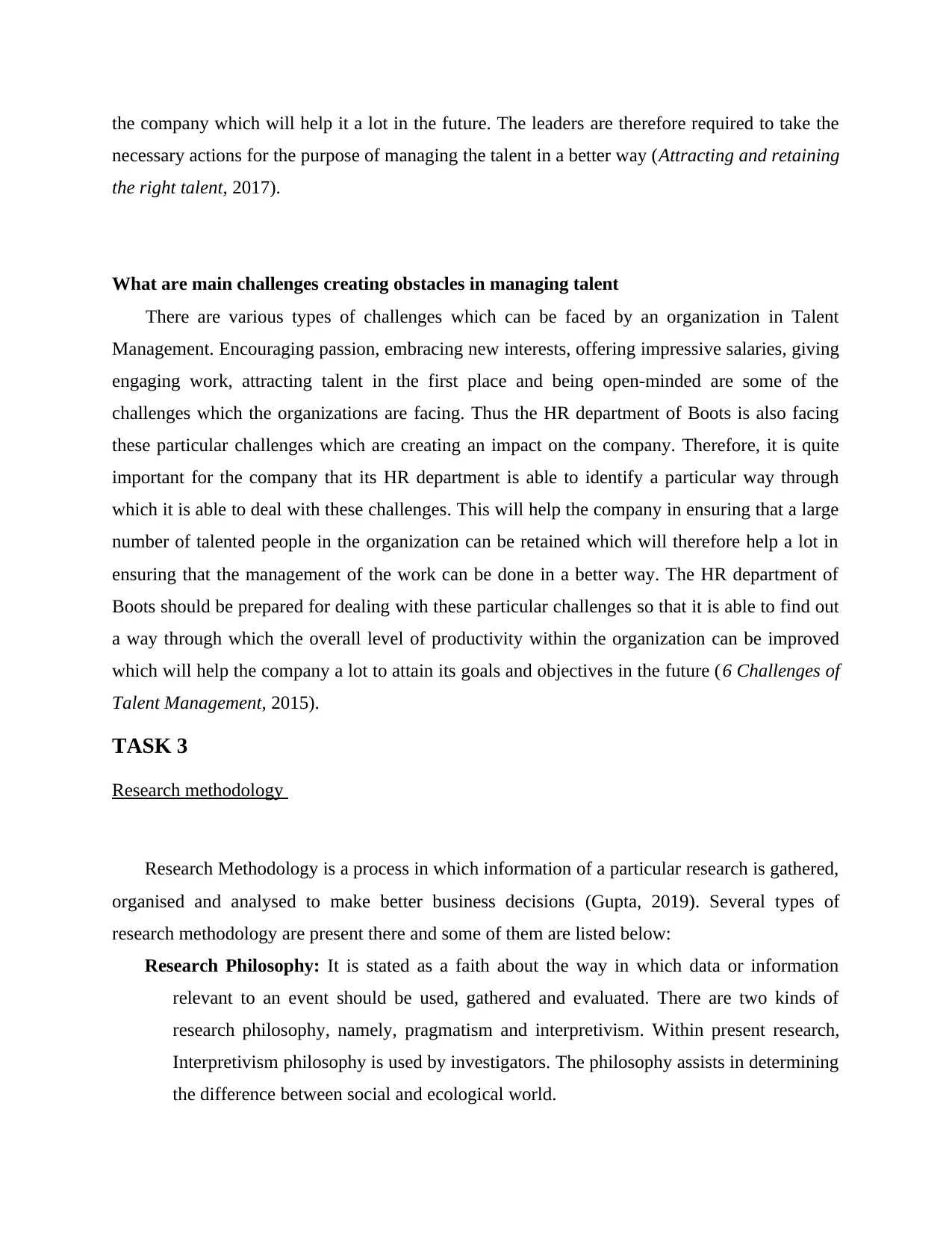
the company which will help it a lot in the future. The leaders are therefore required to take the
necessary actions for the purpose of managing the talent in a better way (Attracting and retaining
the right talent, 2017).
What are main challenges creating obstacles in managing talent
There are various types of challenges which can be faced by an organization in Talent
Management. Encouraging passion, embracing new interests, offering impressive salaries, giving
engaging work, attracting talent in the first place and being open-minded are some of the
challenges which the organizations are facing. Thus the HR department of Boots is also facing
these particular challenges which are creating an impact on the company. Therefore, it is quite
important for the company that its HR department is able to identify a particular way through
which it is able to deal with these challenges. This will help the company in ensuring that a large
number of talented people in the organization can be retained which will therefore help a lot in
ensuring that the management of the work can be done in a better way. The HR department of
Boots should be prepared for dealing with these particular challenges so that it is able to find out
a way through which the overall level of productivity within the organization can be improved
which will help the company a lot to attain its goals and objectives in the future (6 Challenges of
Talent Management, 2015).
TASK 3
Research methodology
Research Methodology is a process in which information of a particular research is gathered,
organised and analysed to make better business decisions (Gupta, 2019). Several types of
research methodology are present there and some of them are listed below:
Research Philosophy: It is stated as a faith about the way in which data or information
relevant to an event should be used, gathered and evaluated. There are two kinds of
research philosophy, namely, pragmatism and interpretivism. Within present research,
Interpretivism philosophy is used by investigators. The philosophy assists in determining
the difference between social and ecological world.
necessary actions for the purpose of managing the talent in a better way (Attracting and retaining
the right talent, 2017).
What are main challenges creating obstacles in managing talent
There are various types of challenges which can be faced by an organization in Talent
Management. Encouraging passion, embracing new interests, offering impressive salaries, giving
engaging work, attracting talent in the first place and being open-minded are some of the
challenges which the organizations are facing. Thus the HR department of Boots is also facing
these particular challenges which are creating an impact on the company. Therefore, it is quite
important for the company that its HR department is able to identify a particular way through
which it is able to deal with these challenges. This will help the company in ensuring that a large
number of talented people in the organization can be retained which will therefore help a lot in
ensuring that the management of the work can be done in a better way. The HR department of
Boots should be prepared for dealing with these particular challenges so that it is able to find out
a way through which the overall level of productivity within the organization can be improved
which will help the company a lot to attain its goals and objectives in the future (6 Challenges of
Talent Management, 2015).
TASK 3
Research methodology
Research Methodology is a process in which information of a particular research is gathered,
organised and analysed to make better business decisions (Gupta, 2019). Several types of
research methodology are present there and some of them are listed below:
Research Philosophy: It is stated as a faith about the way in which data or information
relevant to an event should be used, gathered and evaluated. There are two kinds of
research philosophy, namely, pragmatism and interpretivism. Within present research,
Interpretivism philosophy is used by investigators. The philosophy assists in determining
the difference between social and ecological world.
⊘ This is a preview!⊘
Do you want full access?
Subscribe today to unlock all pages.

Trusted by 1+ million students worldwide
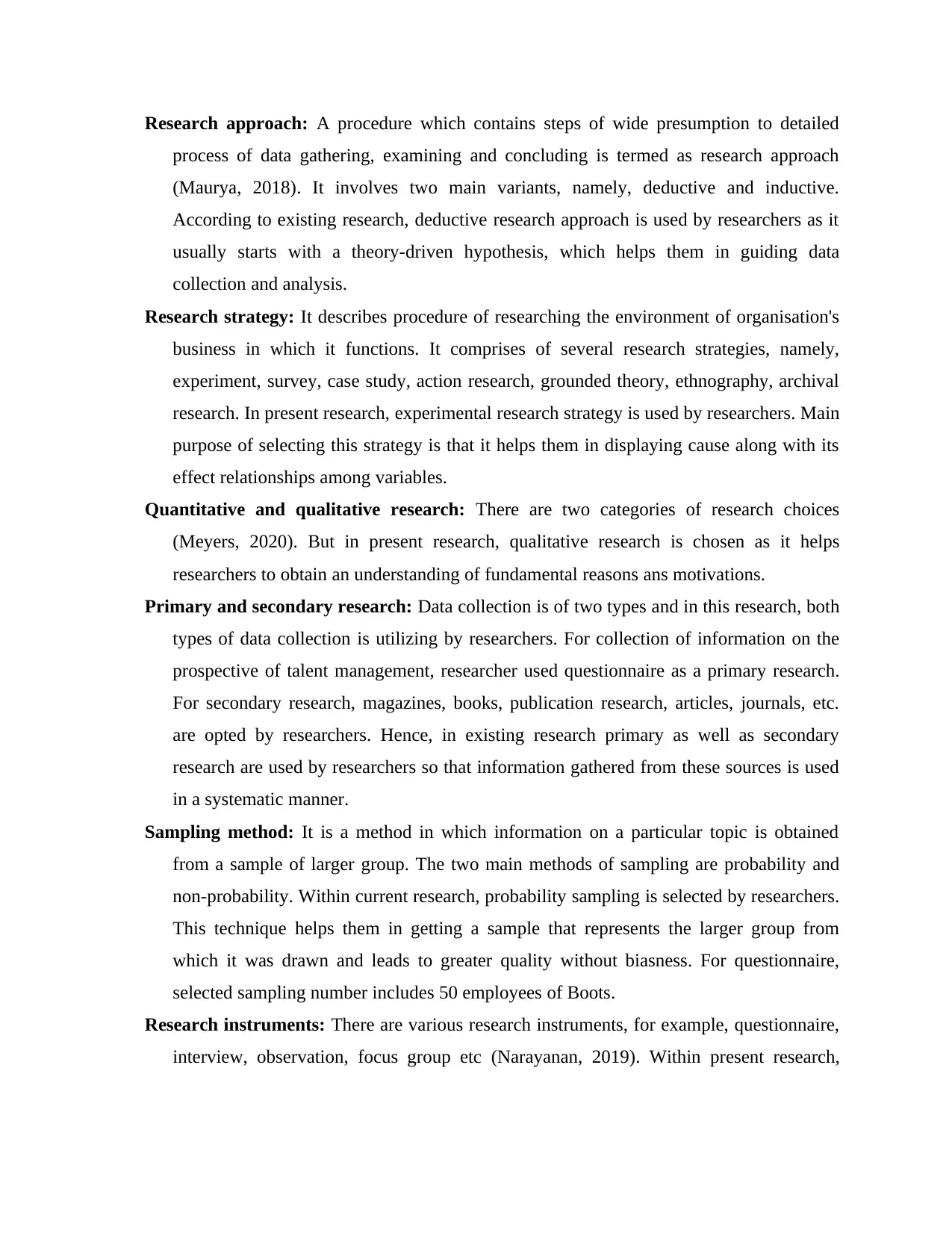
Research approach: A procedure which contains steps of wide presumption to detailed
process of data gathering, examining and concluding is termed as research approach
(Maurya, 2018). It involves two main variants, namely, deductive and inductive.
According to existing research, deductive research approach is used by researchers as it
usually starts with a theory-driven hypothesis, which helps them in guiding data
collection and analysis.
Research strategy: It describes procedure of researching the environment of organisation's
business in which it functions. It comprises of several research strategies, namely,
experiment, survey, case study, action research, grounded theory, ethnography, archival
research. In present research, experimental research strategy is used by researchers. Main
purpose of selecting this strategy is that it helps them in displaying cause along with its
effect relationships among variables.
Quantitative and qualitative research: There are two categories of research choices
(Meyers, 2020). But in present research, qualitative research is chosen as it helps
researchers to obtain an understanding of fundamental reasons ans motivations.
Primary and secondary research: Data collection is of two types and in this research, both
types of data collection is utilizing by researchers. For collection of information on the
prospective of talent management, researcher used questionnaire as a primary research.
For secondary research, magazines, books, publication research, articles, journals, etc.
are opted by researchers. Hence, in existing research primary as well as secondary
research are used by researchers so that information gathered from these sources is used
in a systematic manner.
Sampling method: It is a method in which information on a particular topic is obtained
from a sample of larger group. The two main methods of sampling are probability and
non-probability. Within current research, probability sampling is selected by researchers.
This technique helps them in getting a sample that represents the larger group from
which it was drawn and leads to greater quality without biasness. For questionnaire,
selected sampling number includes 50 employees of Boots.
Research instruments: There are various research instruments, for example, questionnaire,
interview, observation, focus group etc (Narayanan, 2019). Within present research,
process of data gathering, examining and concluding is termed as research approach
(Maurya, 2018). It involves two main variants, namely, deductive and inductive.
According to existing research, deductive research approach is used by researchers as it
usually starts with a theory-driven hypothesis, which helps them in guiding data
collection and analysis.
Research strategy: It describes procedure of researching the environment of organisation's
business in which it functions. It comprises of several research strategies, namely,
experiment, survey, case study, action research, grounded theory, ethnography, archival
research. In present research, experimental research strategy is used by researchers. Main
purpose of selecting this strategy is that it helps them in displaying cause along with its
effect relationships among variables.
Quantitative and qualitative research: There are two categories of research choices
(Meyers, 2020). But in present research, qualitative research is chosen as it helps
researchers to obtain an understanding of fundamental reasons ans motivations.
Primary and secondary research: Data collection is of two types and in this research, both
types of data collection is utilizing by researchers. For collection of information on the
prospective of talent management, researcher used questionnaire as a primary research.
For secondary research, magazines, books, publication research, articles, journals, etc.
are opted by researchers. Hence, in existing research primary as well as secondary
research are used by researchers so that information gathered from these sources is used
in a systematic manner.
Sampling method: It is a method in which information on a particular topic is obtained
from a sample of larger group. The two main methods of sampling are probability and
non-probability. Within current research, probability sampling is selected by researchers.
This technique helps them in getting a sample that represents the larger group from
which it was drawn and leads to greater quality without biasness. For questionnaire,
selected sampling number includes 50 employees of Boots.
Research instruments: There are various research instruments, for example, questionnaire,
interview, observation, focus group etc (Narayanan, 2019). Within present research,
Paraphrase This Document
Need a fresh take? Get an instant paraphrase of this document with our AI Paraphraser
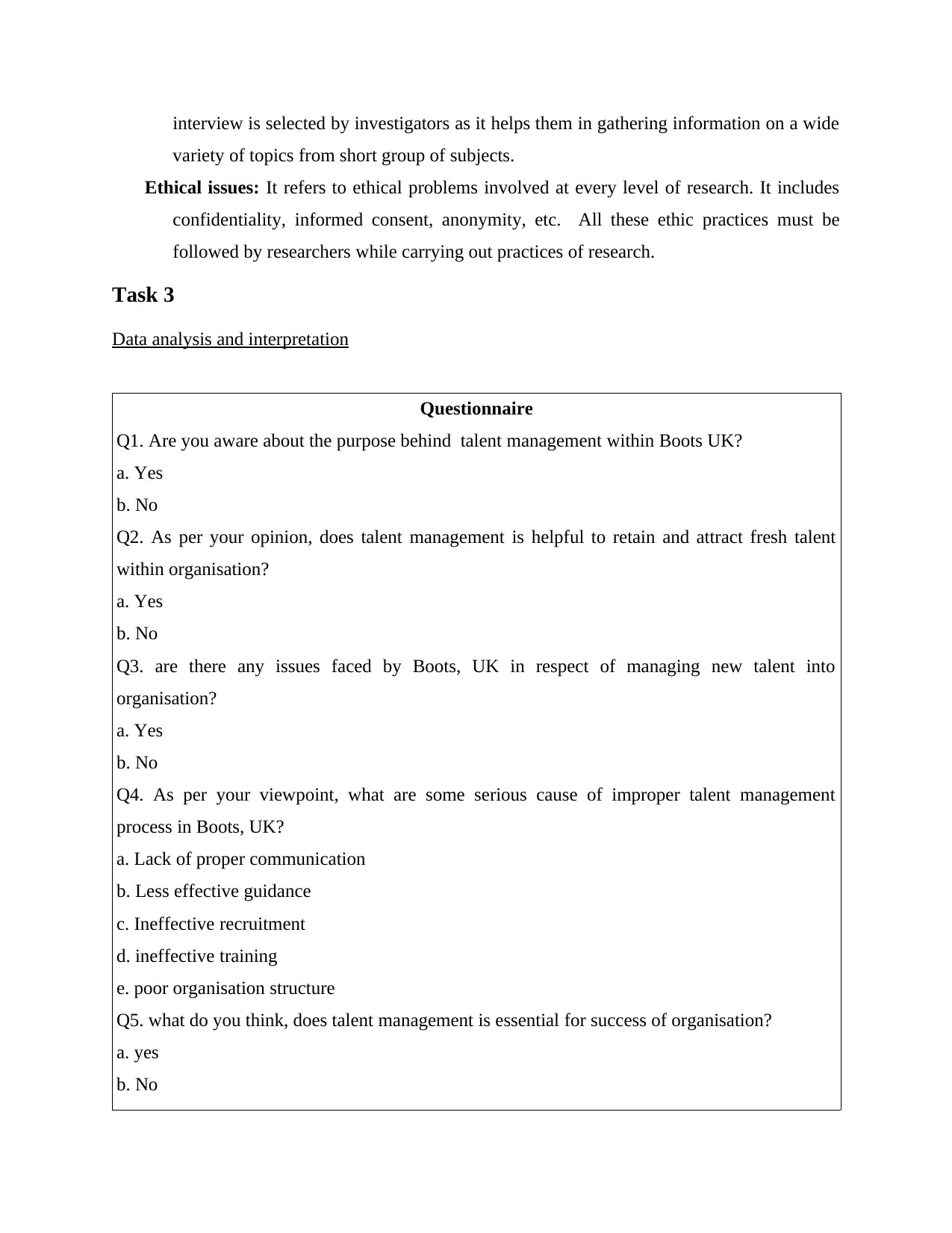
interview is selected by investigators as it helps them in gathering information on a wide
variety of topics from short group of subjects.
Ethical issues: It refers to ethical problems involved at every level of research. It includes
confidentiality, informed consent, anonymity, etc. All these ethic practices must be
followed by researchers while carrying out practices of research.
Task 3
Data analysis and interpretation
Questionnaire
Q1. Are you aware about the purpose behind talent management within Boots UK?
a. Yes
b. No
Q2. As per your opinion, does talent management is helpful to retain and attract fresh talent
within organisation?
a. Yes
b. No
Q3. are there any issues faced by Boots, UK in respect of managing new talent into
organisation?
a. Yes
b. No
Q4. As per your viewpoint, what are some serious cause of improper talent management
process in Boots, UK?
a. Lack of proper communication
b. Less effective guidance
c. Ineffective recruitment
d. ineffective training
e. poor organisation structure
Q5. what do you think, does talent management is essential for success of organisation?
a. yes
b. No
variety of topics from short group of subjects.
Ethical issues: It refers to ethical problems involved at every level of research. It includes
confidentiality, informed consent, anonymity, etc. All these ethic practices must be
followed by researchers while carrying out practices of research.
Task 3
Data analysis and interpretation
Questionnaire
Q1. Are you aware about the purpose behind talent management within Boots UK?
a. Yes
b. No
Q2. As per your opinion, does talent management is helpful to retain and attract fresh talent
within organisation?
a. Yes
b. No
Q3. are there any issues faced by Boots, UK in respect of managing new talent into
organisation?
a. Yes
b. No
Q4. As per your viewpoint, what are some serious cause of improper talent management
process in Boots, UK?
a. Lack of proper communication
b. Less effective guidance
c. Ineffective recruitment
d. ineffective training
e. poor organisation structure
Q5. what do you think, does talent management is essential for success of organisation?
a. yes
b. No
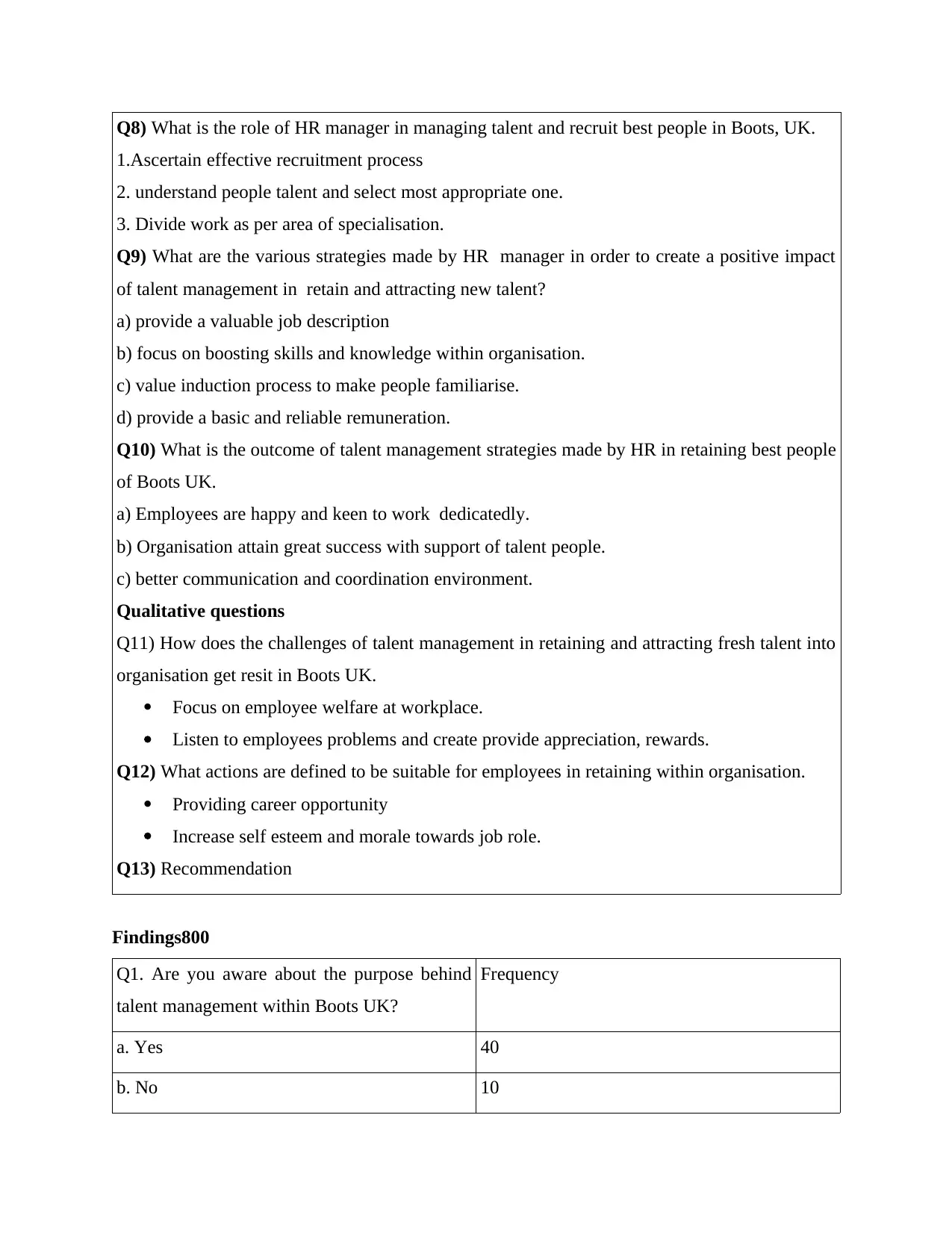
Q8) What is the role of HR manager in managing talent and recruit best people in Boots, UK.
1.Ascertain effective recruitment process
2. understand people talent and select most appropriate one.
3. Divide work as per area of specialisation.
Q9) What are the various strategies made by HR manager in order to create a positive impact
of talent management in retain and attracting new talent?
a) provide a valuable job description
b) focus on boosting skills and knowledge within organisation.
c) value induction process to make people familiarise.
d) provide a basic and reliable remuneration.
Q10) What is the outcome of talent management strategies made by HR in retaining best people
of Boots UK.
a) Employees are happy and keen to work dedicatedly.
b) Organisation attain great success with support of talent people.
c) better communication and coordination environment.
Qualitative questions
Q11) How does the challenges of talent management in retaining and attracting fresh talent into
organisation get resit in Boots UK.
Focus on employee welfare at workplace.
Listen to employees problems and create provide appreciation, rewards.
Q12) What actions are defined to be suitable for employees in retaining within organisation.
Providing career opportunity
Increase self esteem and morale towards job role.
Q13) Recommendation
Findings800
Q1. Are you aware about the purpose behind
talent management within Boots UK?
Frequency
a. Yes 40
b. No 10
1.Ascertain effective recruitment process
2. understand people talent and select most appropriate one.
3. Divide work as per area of specialisation.
Q9) What are the various strategies made by HR manager in order to create a positive impact
of talent management in retain and attracting new talent?
a) provide a valuable job description
b) focus on boosting skills and knowledge within organisation.
c) value induction process to make people familiarise.
d) provide a basic and reliable remuneration.
Q10) What is the outcome of talent management strategies made by HR in retaining best people
of Boots UK.
a) Employees are happy and keen to work dedicatedly.
b) Organisation attain great success with support of talent people.
c) better communication and coordination environment.
Qualitative questions
Q11) How does the challenges of talent management in retaining and attracting fresh talent into
organisation get resit in Boots UK.
Focus on employee welfare at workplace.
Listen to employees problems and create provide appreciation, rewards.
Q12) What actions are defined to be suitable for employees in retaining within organisation.
Providing career opportunity
Increase self esteem and morale towards job role.
Q13) Recommendation
Findings800
Q1. Are you aware about the purpose behind
talent management within Boots UK?
Frequency
a. Yes 40
b. No 10
⊘ This is a preview!⊘
Do you want full access?
Subscribe today to unlock all pages.

Trusted by 1+ million students worldwide
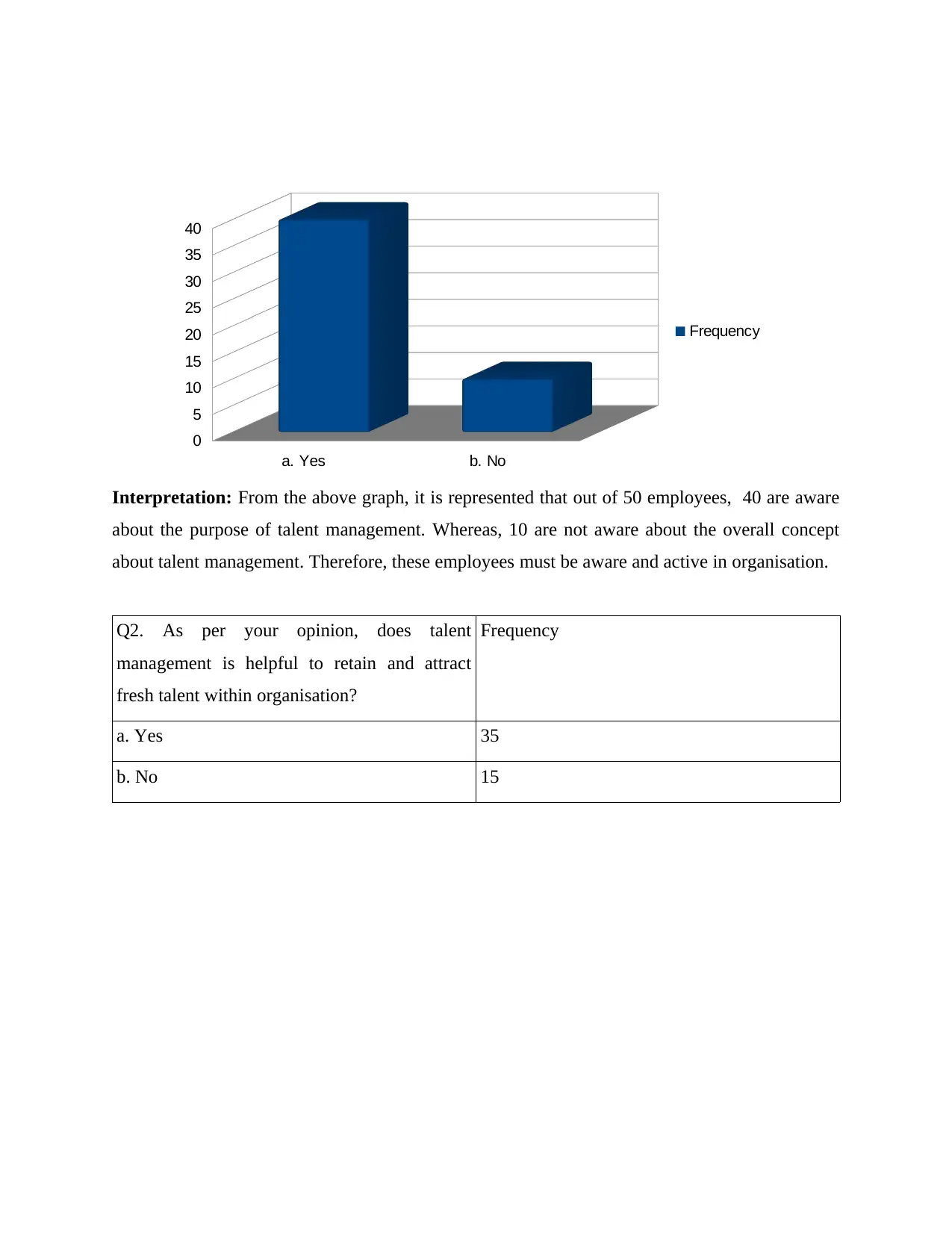
Interpretation: From the above graph, it is represented that out of 50 employees, 40 are aware
about the purpose of talent management. Whereas, 10 are not aware about the overall concept
about talent management. Therefore, these employees must be aware and active in organisation.
Q2. As per your opinion, does talent
management is helpful to retain and attract
fresh talent within organisation?
Frequency
a. Yes 35
b. No 15
a. Yes b. No
0
5
10
15
20
25
30
35
40
Frequency
about the purpose of talent management. Whereas, 10 are not aware about the overall concept
about talent management. Therefore, these employees must be aware and active in organisation.
Q2. As per your opinion, does talent
management is helpful to retain and attract
fresh talent within organisation?
Frequency
a. Yes 35
b. No 15
a. Yes b. No
0
5
10
15
20
25
30
35
40
Frequency
Paraphrase This Document
Need a fresh take? Get an instant paraphrase of this document with our AI Paraphraser
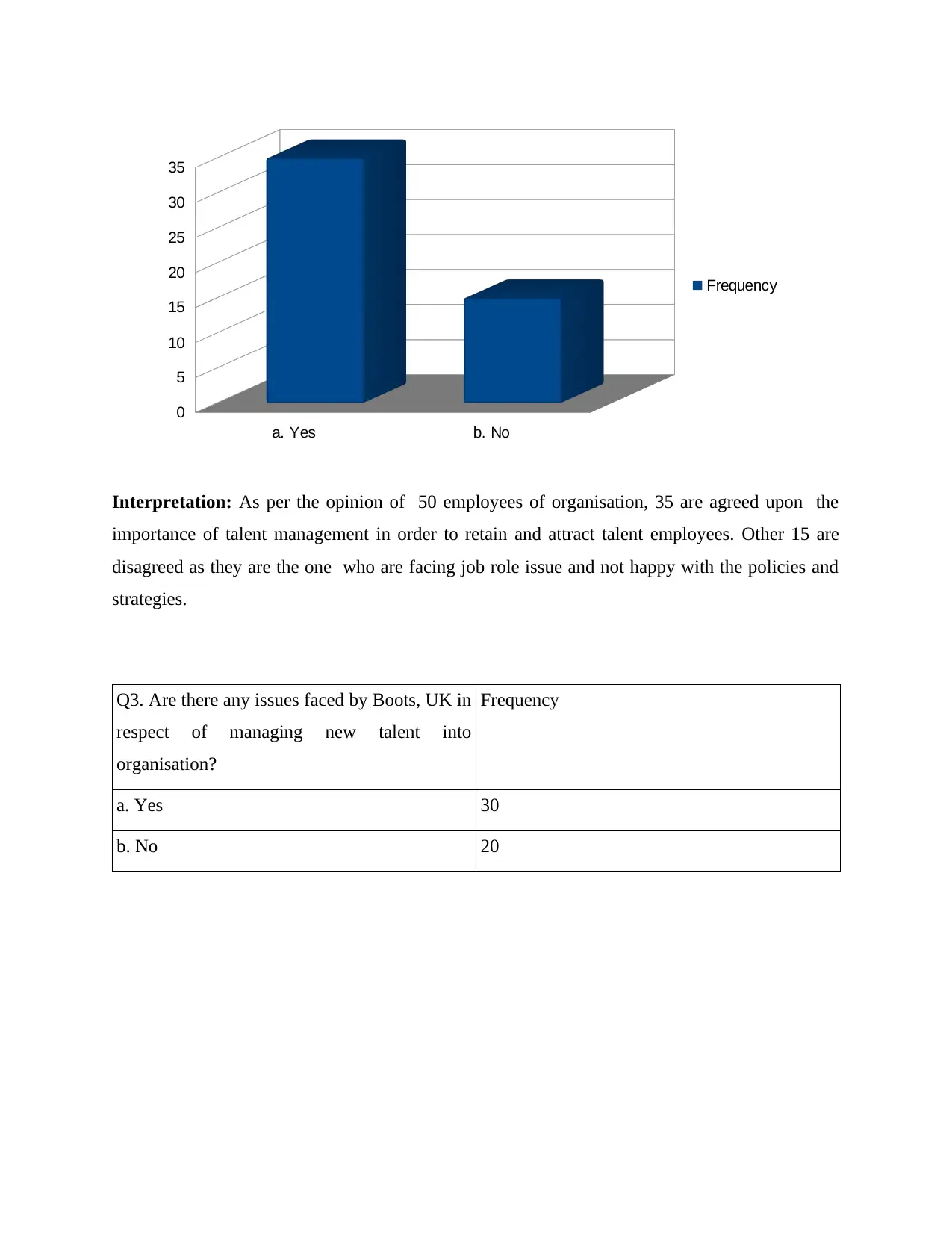
Interpretation: As per the opinion of 50 employees of organisation, 35 are agreed upon the
importance of talent management in order to retain and attract talent employees. Other 15 are
disagreed as they are the one who are facing job role issue and not happy with the policies and
strategies.
Q3. Are there any issues faced by Boots, UK in
respect of managing new talent into
organisation?
Frequency
a. Yes 30
b. No 20
a. Yes b. No
0
5
10
15
20
25
30
35
Frequency
importance of talent management in order to retain and attract talent employees. Other 15 are
disagreed as they are the one who are facing job role issue and not happy with the policies and
strategies.
Q3. Are there any issues faced by Boots, UK in
respect of managing new talent into
organisation?
Frequency
a. Yes 30
b. No 20
a. Yes b. No
0
5
10
15
20
25
30
35
Frequency
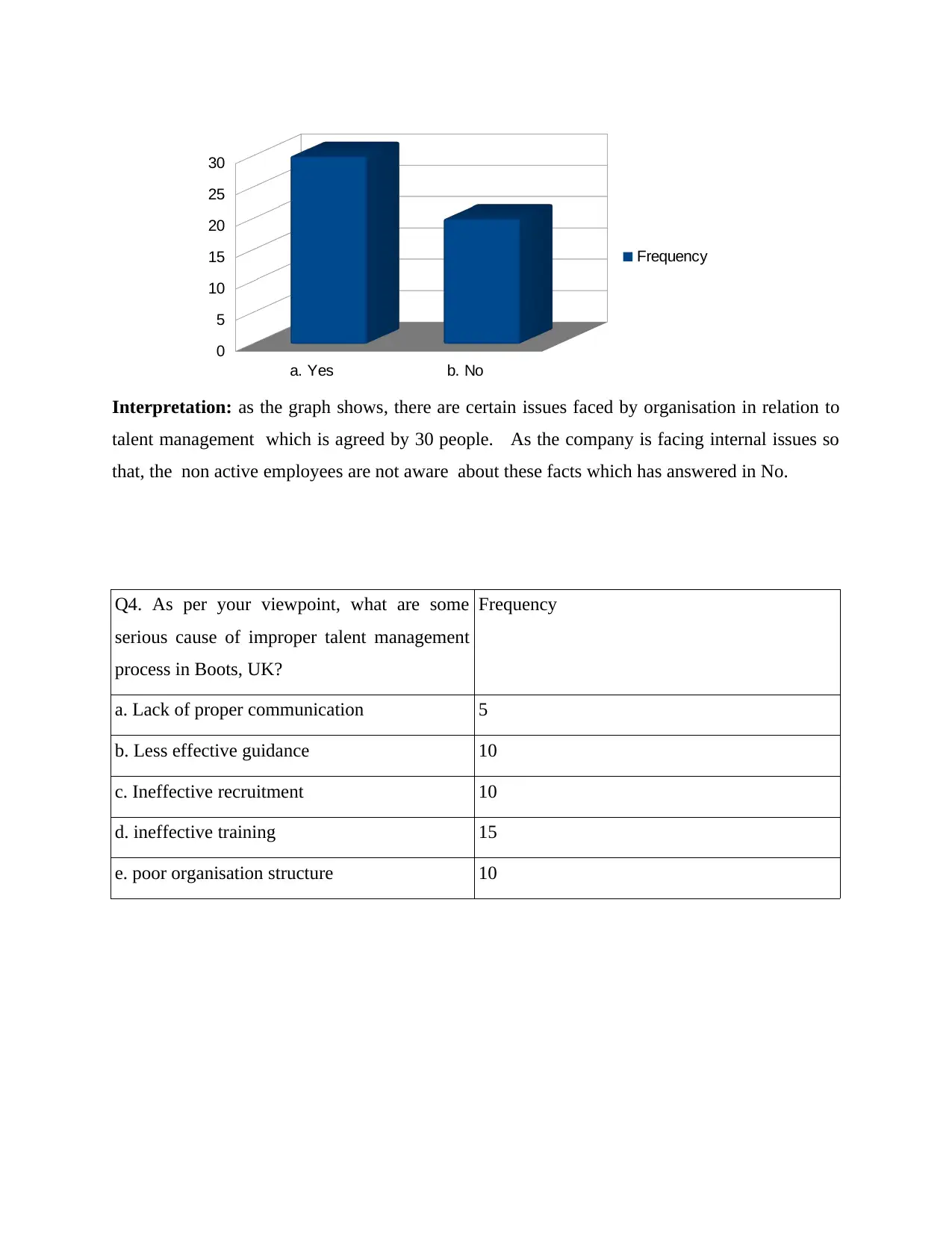
Interpretation: as the graph shows, there are certain issues faced by organisation in relation to
talent management which is agreed by 30 people. As the company is facing internal issues so
that, the non active employees are not aware about these facts which has answered in No.
Q4. As per your viewpoint, what are some
serious cause of improper talent management
process in Boots, UK?
Frequency
a. Lack of proper communication 5
b. Less effective guidance 10
c. Ineffective recruitment 10
d. ineffective training 15
e. poor organisation structure 10
a. Yes b. No
0
5
10
15
20
25
30
Frequency
talent management which is agreed by 30 people. As the company is facing internal issues so
that, the non active employees are not aware about these facts which has answered in No.
Q4. As per your viewpoint, what are some
serious cause of improper talent management
process in Boots, UK?
Frequency
a. Lack of proper communication 5
b. Less effective guidance 10
c. Ineffective recruitment 10
d. ineffective training 15
e. poor organisation structure 10
a. Yes b. No
0
5
10
15
20
25
30
Frequency
⊘ This is a preview!⊘
Do you want full access?
Subscribe today to unlock all pages.

Trusted by 1+ million students worldwide
1 out of 22
Related Documents
Your All-in-One AI-Powered Toolkit for Academic Success.
+13062052269
info@desklib.com
Available 24*7 on WhatsApp / Email
![[object Object]](/_next/static/media/star-bottom.7253800d.svg)
Unlock your academic potential
Copyright © 2020–2025 A2Z Services. All Rights Reserved. Developed and managed by ZUCOL.





